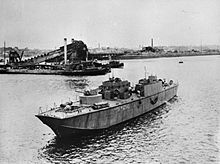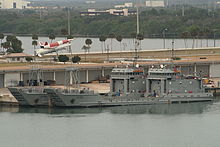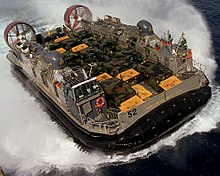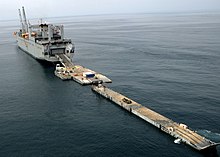Landing craft



Landing craft are boats and seagoing vessels used to convey a landing force (infantry and vehicles) from the sea to the shore during an amphibious assault. Most renowned are those used to storm the beaches of Normandy, the Mediterranean, and many Pacific islands during WWII. This was the high point of the landing craft, with a significant number of different designs produced in large quantities by the United Kingdom and United States.
Because of the need to run up onto a suitable beach, WWII landing craft were flat-bottomed, and many designs had a flat front, often with a lowerable ramp, rather than a normal bow. This made them difficult to control and very uncomfortable in rough seas. The control point (too rudimentary to call a bridge on LCA and similar craft) was normally at the extreme rear of the vessel, as were the engines. In all cases, they were known by an abbreviation derived from the official name rather than by the full title.
Origin

In the days of sail, the ship's boats were used as landing craft. These rowing boats were sufficient, if inefficient, in an era when marines were effectively light infantry, participating mostly in small-scale campaigns in far-flung colonies against less well-equipped indigenous opponents.
In order to support amphibious operations during the landing in Pisagua by carrying significant quantities of cargo, and landing troops directly onto an unimproved shore, the Government of Chile built flat-bottomed landing craft, called Chalanas. They transported 1,200 men in the first landing and took onboard 600 men in less than 2 hours for the second landing.[1]: 40
However during World War I, mass mobilization of troops equipped with rapid-fire weapons quickly rendered such boats obsolete. In February 1915 orders were placed for the design of purpose built landing craft. A design was created in four days resulting in an order for 200 'X' Lighters with a spoon shaped bow to take shelving beaches and a drop down frontal ramp. The first use took place after they had been towed to the Aegean and performed successfully in the 6th August landings at Suvla, Battle of Gallipoli.
'X' Lighters, known to the soldiers as 'Beetles' displaced 135 tons, and were based on London barges being 105 feet, 6 inches long, 21 feet wide, and 7 feet, 6 inchs deep. The engines mainly ran on heavy oil, using whatever was available. Some were converted to carry water and were renamed 'L' Lighters. The British used five of these craft at the Dunkirk evacuation.
A plan was devised to land British heavy tanks from pontoons in support of the Third Battle of Ypres but this was abandoned.[2]
The British produced the Motor Landing Craft in 1920, which could put their then-current medium tank directly onto a beach. From 1924 it was used with landing boats in annual exercises in amphibious landings. It was later called Landing Craft, Mechanized (LCM)[citation needed]. In the 1930s, the British Army carried out divisional-sized amphibious landing exercises. A boat for landing infantry, the Landing Craft Assault, and a new design for landing a tank, the Mechanized Landing Craft, were drawn up after research by the Inter-Service Training and Development Centre in 1938.[3][4]
The United States revived and experimented in their modern approach to amphibious warfare between 1913 to mid-1930s, when the United States Navy and Marine Corps became interested in setting up advanced bases in opposing countries during wartime; the prototype advanced base force officially evolved into the Fleet Marine Force (FMF) in 1933.[5] In 1939, during the annual Fleet Landing Exercises, the FMF became interested in the military potential of Andrew Higgins's design of a powered, shallow-draught boat. These LCVPs, dubbed the 'Higgins Boats', were reviewed and passed by the U.S. Naval Bureau of Construction and Repair. Soon, the Higgins boats were developed to a final design with a ramp, and were produced in large numbers.
World War II types
Nine-ton Landing Craft Navigation (LCN) were used by British "Combined Operations Assault Pilotage Parties" (Royal Marine and Special Boat Service crew) for surveying landing sites.[6]
The Landing Craft Control (LCC) were 56-foot (17 m) U.S. Navy vessels, carrying only the crew (Scouts and Raiders) and newly-developed radar. Their main job was to find and follow the safe routes in to the beach, lanes that had been cleared of obstacles and mines. There were eight in the entire Normandy invasion (two per beach). After leading in the first wave, they were to head back out and bring in the second wave. After that, they were used as all-purpose command and control assets during the invasion.
The smallest landing craft were amphibians such as the U.S.-designed Landing Vehicle Tracked, an amphibious (and sometimes armored) personnel carrier. These were operated by Army personnel, not naval crews. They had a capacity of about three tons. The British introduced their own amphibian, the Terrapin.
The U.S.'s smallest proper landing craft was the Landing Craft Personnel, Large (10 tons). The British's smallest was the Landing Craft Assault (LCA) (13 tons). These were small craft, transported by larger vessels and lowered into the water off the target beach. Typically, they carried 36 fully armed soldiers. The LCPL sometimes came with an enclosed cockpit, and was often used as a command boat. It lacked a loading ramp, which the LCA did have.
The U.S. Landing Craft Vehicle/Personnel (LCVP), also known as a Higgins Boat, was a more flexible variant of the LCPL with a wide ramp. It could carry 36 troops, a small vehicle such as a Jeep, or a corresponding amount of cargo.
Landing Craft, Mechanized were larger (36 tons), capable of carrying one small tank or 100 troops.
None of the above was capable of making a voyage longer than about 6–12 hours, mainly through fuel limitations. The Landing Craft Utility (LCU) is used to transport equipment and troops to the shore. They are capable of transporting tracked or wheeled vehicles and troops from amphibious assault ships to beachheads or piers.

Then came the Landing Craft Infantry (Large) or LCI(L), capable of serious voyages under its own power. Some sailed directly from the United Kingdom to take part in the Operation Torch landings, and U.S. Navy LCIs island hopped across the Pacific. LCI(L)s were about 158 feet long, 23 feet wide, and carried around 200 troops. There were several sub-types of the craft, with the LCI(L) infantry carrier dominating—but LCIs also served as rocket (LCI(R)) and mortar (M), and gunboat (G) platforms, as well as a flotilla flagship (FF). While still intended to run up on the beach, these tended to have a normal type bow with stepped ramps on each side for the troops to disembark. The LCI was re-classified Landing Ship Infantry (LSI) by the U.S. in 1949.
Of a similar size was the Landing Craft Tank, which could carry up to four tanks or other vehicles. These had a ramp at the front that dropped for vehicles to go ashore. An open space behind the ramp, the tank deck, held vehicles. There were several different designs and sizes.
The next step up in size was the Landing Ship Tank (LST). This carried more vehicles than the LCT (20 in the US versions) and had normal looking bows, though the bows were actually formed by doors that opened for the unloading ramp to drop. Fully loaded, these displaced more than 3,000 tons, more than any Royal Navy destroyers of the period.
Finally, there was the Landing Ship Dock, which had a large open compartment at the back. Opening a stern door and flooding special compartments opened this area to the sea so LCI-sized vessels could enter or leave. Initial British nomenclature used different type names leading to alternate names such as Assault Landing Craft, Infantry Landing Craft, and Tank Landing Craft.
Due to their small size, the majority were not given names and were simply given serial numbers, e.g., LCT 304. The LSTs were an exception to this, since they were similar in size to a small cruiser. Three British-built LSTs were named as well, HMS Boxer, HMS Bruiser and HMS Thruster, which were larger than the U.S. design. They also had proper funnels.
Armament
Many DUKWs were fitted with anti-aircraft .50 cal. Browning machine guns. LCAs crews were issued with .303 cal. Lewis Guns for use as anti-aircraft protection, or for use against shore targets mounted in a light machine gun shelter on the forward-port side of the craft. Later models were fitted with 2x 2"mortars, and 2x Lewis or .303 Bren Guns. LCM 1 crews were issued with Lewis guns, and many LCM 3s had .50 cal. Browning machine guns mounted for anti-aircraft protection.[7] Opportunities for troops on board to use their own weapons presented themselves.
LCIs and LCTs carried weapons such as the Oerlikon 20 mm cannon each side of the bridge structure. LSTs had a somewhat heavier armament.
Imperial Japanese Navy landing craft
The Imperial Japanese Navy operated the following types of landing craft during World War II
WWII special craft
Some landing craft were converted for special purposes either to give defence for the other landing craft in the attack or as support weapons during the landing.
Landing Craft Assault (Hedgehog)
The LCA(HR) was a converted British LCA. It carried a battery of 24 spigot mortars, the Royal Navy's Hedgehog anti-submarine weapon instead of personnel. The mortars were fired as a barrage onto the beach to clear mines and other obstructions. Having discharged its mortars and its duty, the LCA(HR) would leave the beach area. They were towed to the beach by larger craft, such as the LCT, which the Royal Engineer assault teams with their specialist vehicles and equipment to complete the beach clearance.
Three flotillas (of 18, 18 and 9 craft) were used at Juno, Gold and Sword beaches.[8]
Landing Craft Flak

The Landing Craft Flak (LCF) was a conversion of the LCT, intended to give anti-aircraft support to the landing. They were first used in the Dieppe Raid early in 1942. The ramp was welded shut, and a deck built on top of the Tank deck. They were equipped with several light anti-aircraft guns—a typical fitting was eight 20 mm Oerlikons and four QF 2 pdr "pom-poms" and had a crew of 60. On British examples the operation of the craft was the responsibility of RN crew and the guns were manned by Royal Marines. They carried two naval officers and two marine officers.
Landing Craft Gun

The Landing Craft Gun (LCG) was another conversion of the LCT, intended to give supporting fire to the landing. Apart from the Oerlikon armament of a normal LCT, each LCG(Medium) had two British Army 25 pounder gun-howitzers in amoured mountings, while LCG(L)3 and LCG(L)4 both had two 4.7 inch naval guns.[9]Crewing was similar to the LCF. LCGs played a very important part in the Walcheren operations in October 1944.
Landing Craft Rocket
The Landing Craft Tank (Rocket), LCT(R), was a LCT modified to carry a large set of launchers for the British RP-3 "60 lb" rockets mounted on the covered-over tank deck. The full set of launchers was "in excess of" 1,000 and reloads totaling 5,000 rockets were kept below. The firepower was claimed to be equivalent to 80 light cruisers or 200 destroyers.
The method of operation was to anchor off the target beach, pointing towards the shore. The distance to the shore was then measured by radar and the elevation of the launchers set accordingly. The crew then vanished below (apart from the commanding officer who retreated to a special cubby hole to control things) and the launch was then set off electrically. The launch could comprise the entire set or individual ranks of rockets.[10]
A full reload was a very labor-intensive operation and at least one LCT(R) went alongside a cruiser and got a working party from the larger ship to assist in the process.
Landing Craft Support

The Landing craft Support were used to give some firepower close in.
The Landing Craft Support (Medium) (LCS(M)), Mark 2 and Mark 3 were used by the British forces at Normandy. The crew was Royal Navy with Royal Marines to operate the weapons: two 0.5 inch Vickers machine guns and a 4-inch mortar to fire smoke shells.
The Fairmile H Landing Craft Support (Large) had armour added to its wooden hull and a turret with an anti-tank gun fitted. The LCS(L) Mark 1, had a Daimler armoured car turret with its QF 2–pdr (40 mm) gun. The Mark 2 had a QF 6–pdr (57 mm) anti–tank gun.
The American Landing Craft Support was larger, each armed with a 3-inch gun, various smaller guns, and ten MK7 rocket launchers.
Inflatable landing craft
Inflatable boats were often used to transport amphibious troops from high speed transports and submarines. The United States used a 7 man Landing Craft, Rubber (Small) (LCR-S) and a 10 man Landing Craft, Rubber (Large) (LCR-L[11]).
Current Landing Craft


Amphibious mechanized utility and landing craft
Mechanized utility and landing craft were the kind used during the second world war and while the mechanized landing craft of today are similar in construction, many improvements have been made. for example landing craft such as the LCM-8 of the US Navy) are capable of a military lift of 183 metric tons at a speed of 22 km/h, carrying even heavy equipment such as M1 Abrams tanks. Landing craft can mount several machine guns or similar weapons for the defense of troops and/or vehicle crews inside.
Air-cushioned landing craft

The air cushioned landing craft (Landing Craft Air Cushion, or LCAC in the US Navy) is based on small to mid sized multi-purpose hovercraft, Also known as "over the beach" ("OTB") craft, they allow troops and material to access more than 70 percent of the world's coastline, while only approximately 15 percent of that coastline is available to conventional landing craft. Like the mechanized landing craft, they are usually equipped with mounted machine guns, although they also support grenade launchers and heavy weapons. These vehicles are commonly used in the United States Navy, the Royal Navy, the Russian Navy, and the Hellenic Navy.
Landing barges

Landing barges were adaptations of British Thames barges and lighters as landing craft. In size they came between the landing craft and landing ships. They were used at all beaches during the landings at Normandy manned by British crews.
Some were fitted with engines while others were towed to the beach. They were used for defence, transportation, supply (food, water and oil) and repair (fitted out with workshops).
Those fitted for vehicle carrying had a ramp fitted in place at the rear and they had to back onto beaches. They would work from ships and coasters to the shore and back.
Two flotillas were made up of "flak barges" to provide defence of the beaches. Like landing craft, flak barges carried A/A guns: two 40 mm Bofors and two 20 mm Oerlikon, with army gunners and naval crew.
The Landing Barge, Kitchen (LBK) was fitted with a large superstructure containing the galley. With a crew of 20 plus they could carry food for 800 for a week and provide 1,600 hot and 800 cold meals a day, including freshly baked bread.[12]
See also
Notes
- ^ Carlos Lpez Urrutia (30 June 2008). Guerra Del Pacifico. Lulu.com. ISBN 978-1-4357-1183-9. Retrieved 26 April 2013.
- ^ FLtecher, D British Mark IV tank New Vanguard, Osprey Publishing
- ^ William F Buckingham. D-Day the First 72 hours Tempus Publishing, Stroud. 2004
- ^ Maund, LEH Assault From the Sea, Methuen & Co. Ltd., London 1949
- ^ Allan R. Millett, "Semper Fidelis: The History of the United States Marine Corps", (New York City, NY: The Free Press, 1991).
- ^ "Accessed 18th March 2008". Combinedops.com. 1943-03-09. Retrieved 2009-05-10.
- ^ US Navy ONI 226 Allied Landing Craft and Ships, US Government Printing Office, 1944.
- ^ "Major Landing Craft of World War II". The Royal Marines Museum. 6 October 2011.
- ^ Brown D K, Nelson to Vanguard p 145
- ^ British Landing Craft of World War II » Naval Historical Society
- ^ "US Navy Small Landing Craft, 1940-1945". Ibiblio.org. 2006-05-25. Retrieved 2009-05-10.
- ^ "Thames barge converted into landing craft for Normandy landings". Naval-history.net. Retrieved 2009-05-10.
